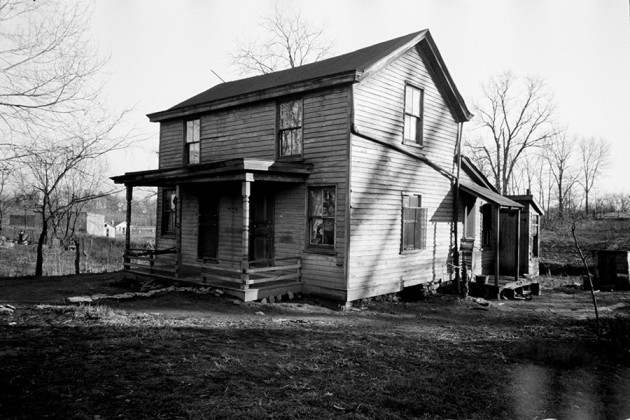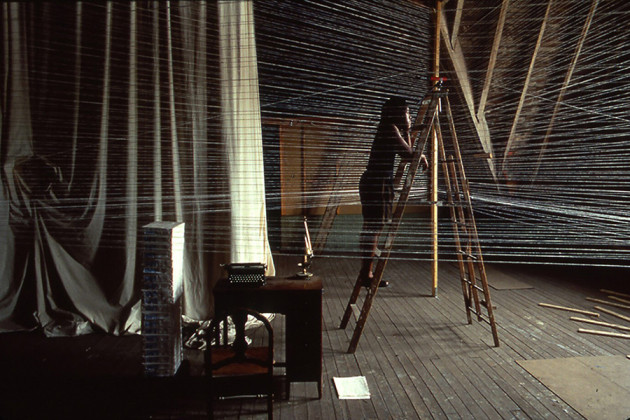Whose House Is This?
(…) Whose night keeps out the light in here? Say who owns this house? It is not mine, this House is strange. Its shadow lies. Say, tell me? Why doesn’t its lock fit my key?
Toni Morrison ~ Home
The shrill echoes of Toni Morrison's "Whose house is this?"1 can be clearly heard, the moment she realizes that her entire universe has abruptly turned its face to the opposite wall, which is now her own house of fiction, her own house of memories, her own house of light and shadow has become the house of darkness, the house of dumbness and the house of suffocation. Like all eight tornal lyrics, the issue of strangeness, however, fits into the sinuous form. Morrison's chromatic wandering between notes and houses, like other eight-tornal poems, depicts music's unwillingness to resolve or reconcile to what she recalls as home.
Here, the time has fallen at the unresolved space. When Morrison's restless journey between the minor key associated with the sorrow of despair, the middle passage, the runaway slave, the migrant journey, the exile's quest, the encamped waiting of the refugee, all of the effects which she had drawn in her novels by sentimental sincerity are confronting itself at the 'doorstep' of that home. The doorstep where the visitor or perhaps a traveler is passing through and facing with questions that have been asked before repeatedly, the questions that are unable to reconcile with its own presence.
What does it mean to be at home? What forms of solidarity and alignment can be made possible by living "side by side" with other differences and alterities? Must we live in the shadow of sovereignty, or can we overcome it? Or are we trapped in its ambiguity?
Morrison's work frequently takes time of the signature turbulent of historical moments or political moments in transition, embodying a split and yet double bind, re-memory in which the polarity of past and present give way to what Walter Benjamin once called historical constellation. Some of its parts that were visible in this encounter suddenly became visible, active, and meaningful as it re-traveled, as flash, into the historical present.
In such oeuvre, diaspora, exile, escape (however one would like to name it) therefore are never merely tales of departure or displacement; there always has to be the history or the past that is reckoning to "return", the return that is a reminder to the very present moment of now. It is the return that is not, therefore, a problem of delay or not being present at the time. Rather, it is the return that is particularly about the moment of history where time comes back on itself. That is the time which comes as a return to make us remember that the history is not what has been left behind, but the history is now which is continually returning back as a reminder. To demonstrate the cost and value of engagement in that continuous return, introduce the epochal idea, such as the idea of home itself. Thus, to return, it’s the particular time that is coming back as a witness, not something that passes through.
A boundary is not that at which something stops but, as the Greek recognized, the boundary is that from which something begins…
Heidegger ~ Building, Dwelling, Thinking
In the summer of 1990, towards the midst of Morrison's despair, Homi K. Bhabha wrote an article titled “Beyond the Pale Art in the Age of Multi-cultural Translation”. He takes a measured step ahead and considers this time to uplift the idea of home in the context of "inherited nations and cultural location"2. That is, what we hear is no longer the case in Morrison's tornal lyrics. It's as if for her, the idea of home is fading and she won't be able to hold on any longer, but oddly, it's as if she's still yearning for it, hoping that one day she'll return to that home, which also has almost become stranger to her. It’s almost aporia that is (not in the sense of being lost) but rather a continual, constant negotiation in the literal sense of what one could say the idea that is not so foreign to us, the idea that is not other than but to be at home.
Thus, it is assumed by Bhabha that, it is the urgency of our time to re-locate the very idea of home, but this time in the realm of boundary. That is because most of our very presence today (as it was yesterday) exists in our survival over living on these boundaries, for which there seems to be no proper statement other than Heidegger’s “the boundary where something begins”3.
The boundary here is neither a new horizon nor a leaving behind of the past -it is in- between those beginnings and endings where one perhaps fallen or thrown vis-á-vis to negotiate or to reconcile each side. It is the particular transition between space and time that constantly crosses-over complex figures of differences or engagements between past and present, inside and outside, inclusion and exclusion. Above all else, there is a sense of distortion or disorientation in between the direction of space and time, for instance, referring to the boundary: an unending, restless moment that is caught so well in the French rendition of the word -au delâ- here and there, all around, fort/da, hither and thither, back and forth.
What is theoretically unavoidable and therefore valuable is that the term boundary; there is a shift from assumed singularities or linear narratives of origin and initial subjects. That is, focus more on those moments or processes which are produced in the articulation of "differences". These differences are found in "in-between" spaces where they provide engagements of selfhood as well as communality, which later initiates negotiating forms of effects and spaces for collaboration and contestation.
It is in the emergence of the interstice that overlaps with the displacement of domains over differences where the inter-subjective and collective effects of experiences or their values are negotiated. How do subjects form their effects in between and affiliate themselves with these differences? How are strategies of engagement and affiliations formulated, despite the fact that shared histories of deprivation exist but the hope of exchanging values, meanings, and priorities may still be collaborative, dialogical, and even hospitable?
The force of these questions might seem weighed down by the optimism of existentialist inquiry, but one cannot ignore that the question here itself is as crucial as other contemporary questions. Existentialism, as defined by Marleu Pontey, is "the direct description of human experience to the world; it is the background experience that guides every conscious action"4. As experience is a pioneering substance, action is going to be taken accordingly. Furthermore, he also argues that such an experience is what makes human beings question their existence. That is to say, the question of existence is a condition that includes a question about its own existence in the world. It is in the concrete form of existence, what could be described as an experience of questioning existence. Therefore, the experience of the world is what is directly oriented to being in the world, and "we cannot separate ourselves from it."
Terms such as engagements or negotiations, whether antagonistic or affiliative, are produced by "differences". It is not so much as pre-given or fixed entities within the cultural traits. As these engagements are complex and fluid, their negotiations with differences are constantly on-going conditions. Thus, the "boundaries" engagements may often be found with conflictual differences; they might confound our definitions of modernity between the private and public, high and low, and challenge normative expectations of continual interactions.
Although the act of such constant interactions is an ambivalent process and that such cross-negotiation requires understanding of the recognition of an "open border" between these effects, it unsettles the presumed authority of both as knower and known. It remains the contribution of the borderline artists in this show to perform a poetic of the open border, or what has been described above as "the overlapping and inter-living, the hither and thither."
“I wanted to make shapes that set up situations that are kind of open. My work has a lot to do with a kind of fluidity, a movement back and forth, not making a claim to any specific or essential being”5 writes Renee Green, the African American artist. She considers the importance of comprehending differences in the effects of identities that are alienated from themselves, identities that are articulated from singular to collective bodies.
If Renee Green’s brings up an interrogatory, interstitial space between the acts of back and forth, then her creative intervention within these in-between moments has considerable value. Green’s "architectural" site-specific work, sites of genealogy (made in 1990 for the exhibition "out of site" PS. 1, Museum, the Institute for Contemporary Art, Long Island City, New York), displays how identities of difference are often constructed - black/white, self/other. Green makes a metaphor for the building itself rather than using the gallery space.
“I used architecture literally as a reference, using the attic, the boiler room and the stairwell to make associations between certain binary divisions such as higher and lower, heaven and hell. The stairwell became a liminal space, a pathway between the upper and lower areas, each of which was annotated with plaques referring to the blackness and whiteness.”
The stairwell at this point is a liminal space where, in between effects of identity, becomes the subject of symbolic interactions, the connective space that bridges the difference between higher and lower, black and white. The hither and thither of the stairwell is the temporal movement and passage that allows and prevents either end of it from settling into primordial polarities. This interstitial space between fixed identifications opens up the possibility of engagement with differences without any hierarchy:
“I always went back and forth between racial designation and designations from physics and other symbolic nations.”
The boundary here signifies an important tradition point here between back and forth that mark’s interactions, promises engagements, and invites hospitality. It is our intimations of exceeding the barrier that are unknowable, unpresentable without a return to the "present", and that are in a constant state of repetition, becoming increasingly disjunct and displaced. The imagination of spatial interactions, to live in some way within the boundaries of our time, highlights temporal and social differences that disrupt our understanding of engagements. The present no longer continues with the past or future, it’s almost diminished between them. We are now confronted with what Walter Benjamin described as the "blasting moment from the homogenous course of history, "establishing" a conception of the present "at the time of now"6.
If the time of now is - the narrative of cultural and political diaspora, the major social displacement of immigrants and communities, the poetics of exile, the grim prose of political and economic refugees. Then, it is in this sense that "boundary" is an unavoidable notion and, as Heidegger describes, "the way that even a difference bridge escorts the lingering and hastening way of men to and fro, so that they may get to other banks, the bridge gathers as a passage that crosses..."
Therefore, insisting on being at the "boundary" inhabits an intervening space. By any sort of side-by-sidedness, that is what motivates us to "dwell". Dwelling is a return to the present. That is the present moment of now, the precise moment between past and future. It is to engage with the past and the future, and it is here the present moment that becomes a space of intervention in the here and now.
The boundary at this point is work that encounters "difference" that is neither part of the continuum of past nor future, nor is it "difference" that can be contained in the mimesis of original and copy. The image of "difference" contains the disjunction that is represented as epistemological distance in both senses. The boundary as a point of difference is a rebellious act of interaction and engagement. It reimagines the past and future as a contingent "in-between" space that innovates and disrupts the present's performance. As a result, the past-future is part of the necessity not the nostalgia of living.
References
1 Whose House is this? (2013). From Andre Previn and Toni Morrison’s Honey and Rue: Commissioned for Kathleen Battle, the song cycles on the Black experience.
2 Bhabha, H. K. (1993). Beyond the Pale: Art in the Age of Multicultural Translation. pp. 62-71, R. Lavrijsen ed. Cultural Diversity in the Arts.
3 Heidegger, M. (1954). “Building Dwelling, Thinking,” in poetry, Language, Thought, Hofstadter. Trans (New York: Harper & Row)
4 Scott, A. (2002). Phenomenology of Perception. Merleau-Ponty’s Phenomenology of Perception. https://www.angelfire.com/md2/timewarp/merleauponty.html
5 Renee Green. (1990). interviewed by Elizabeth Brown, in the catalogue published for social studies, Young Americans (Oberlin, Ohio: Alien Art Museum, Oberlin College)
6 Walter Benjamin (1969). Thesis on the Philosophy of History,” in illumination, Harry Zohn, trans, (New York: Schocken Books)
 09.12.2022
09.12.2022

















